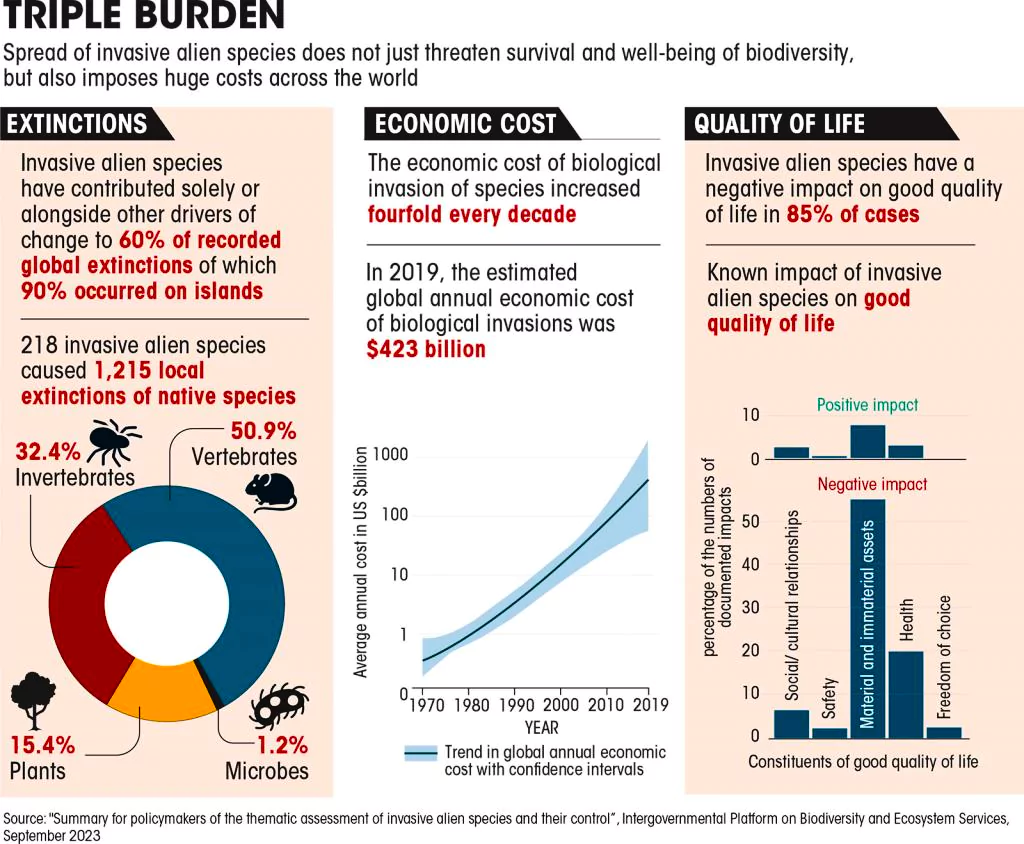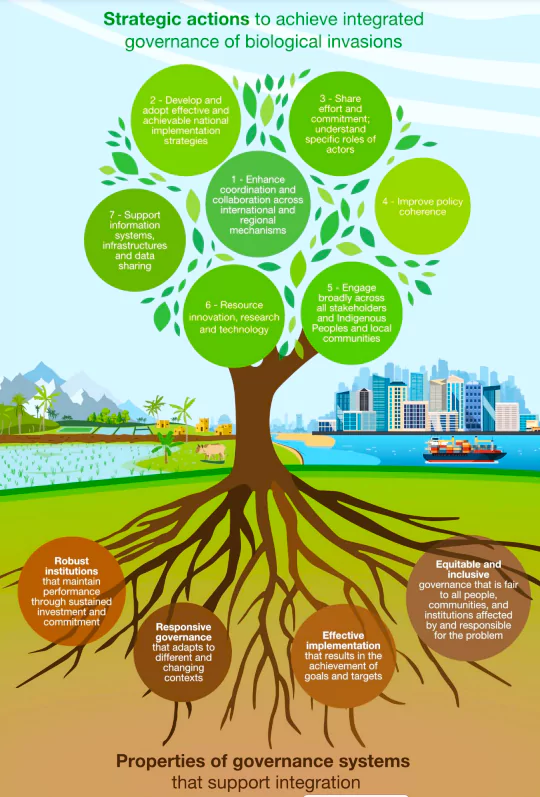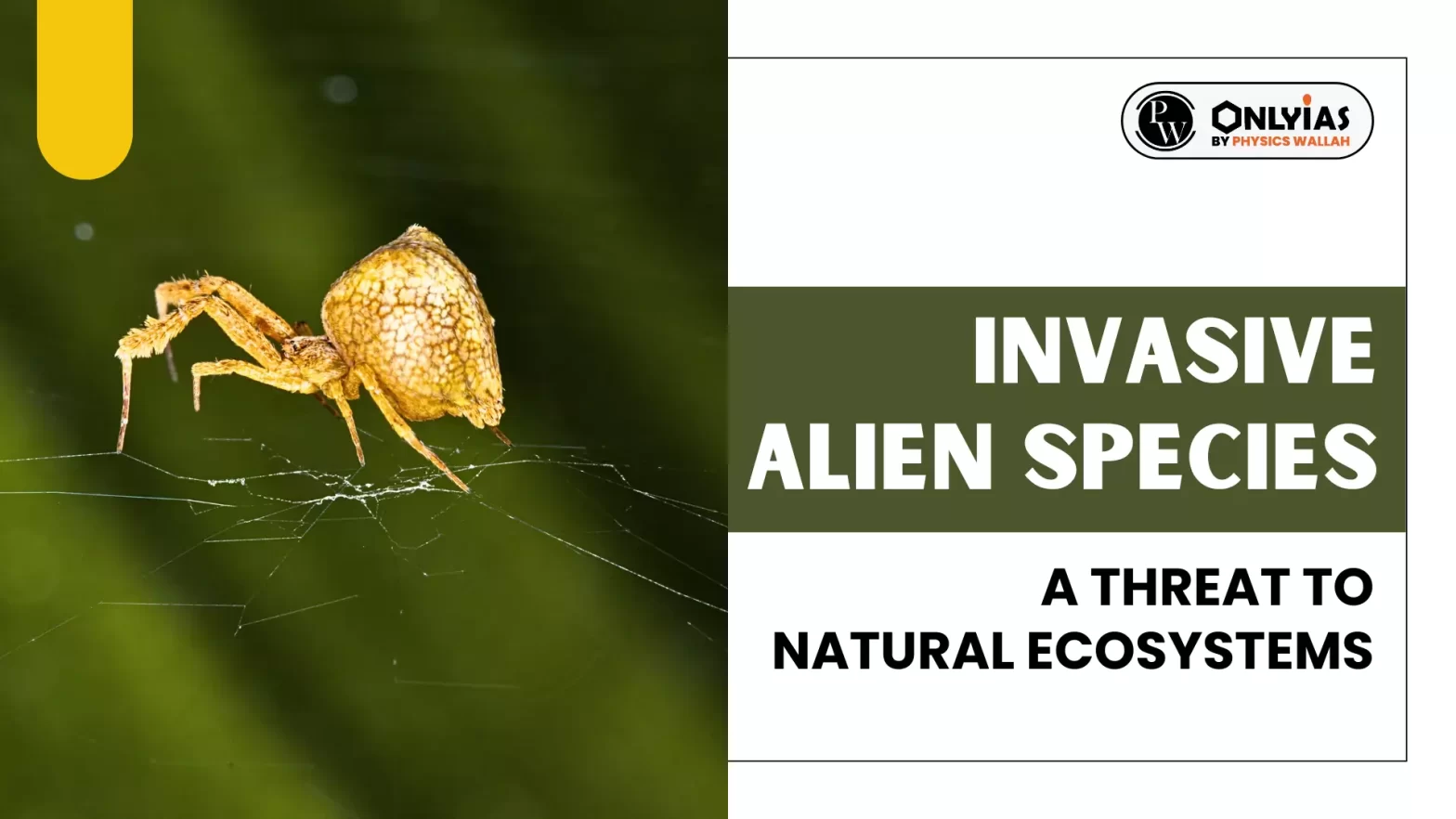Context
The Andaman and Nicobar Islands administration recently sought help from the Wildlife Institute of India to manage the teeming population of chital (spotted deer) in Ross Island (officially known as the Netaji Subhash Chandra Bose Island).
About Chital (Spotted Deer or Axis Deer)
Chital, native to mainland India, were introduced to the tiny island by the British in the early 20th century. Having no natural predators or competitors, and being good swimmers, chital swiftly spread across the Andamans.
|
About Invasive Alien Species (IAS)
-
Defined by the Convention on Biological Diversity (CBD):
- It defines Invasive Alien Species (IAS) as “species whose introduction and/or spread outside their natural past or present distribution threatens biological diversity”.
Enroll now for UPSC Online Course

-
Characteristics of Invasive Alien Species:
- “Arrive, Survive and Thrive”– As per CBD, Invasive Alien Species need an introduction either through natural or human intervention, survive on native food resources, reproduce at a fast rate, and edge out native species in the competition over resources.
- Example: The Wildlife Institute of India (WII) found that the co-occurrence of lantana and Pogostemon benghalensis caused a “significant decline in the richness of native plants and that of palatable plants” in Madhya Pradesh’s Kanha Tiger Reserve.
-
Some Examples of Invasive Alien Species in India
-
- The list of invasive alien species in India is dominated by certain species of fish such as the African catfish, Nile tilapia, red-bellied piranha, and alligator gar, and turtle species such as the red-eared slider.
- Lantana camara: Its invasion has resulted in the scarcity of native forage plants for wild herbivores; it has invaded more than 40% of India’s tiger range.
- Prosopis Chilensis: A drought-resistant plant native to the arid regions of South American countries is threatening the native vegetation of islands in the Gulf of Mannar Biosphere Reserve.
- Prosopis juliflora: It is a water-guzzling invasive species which extracts maximum water from the ground impacting the groundwater levels adversely affecting local biodiversity and ecology.
Reason for the Spread of Invasive Alien Species (IAS)
- Globalization: It has resulted in greater trade, transport, travel and tourism, all of which can facilitate the introduction and spread of Invasive Alien Species.
- Climate Change: Warming temperatures and climate change could favour the “expansion of invasive species’’.
- Example: Warmer winters allow insects like the Asian longhorned beetle (native to eastern Asia) to survive in colder regions, posing a threat to hardwood forests.
 Habitat Degradation: With rising urbanisation, construction projects, deforestation, and unsustainable land-use changes are also increasing and disrupting and degrading the native ecosystems and allowing Invasive Alien Species to establish themselves in those habitats easily.
Habitat Degradation: With rising urbanisation, construction projects, deforestation, and unsustainable land-use changes are also increasing and disrupting and degrading the native ecosystems and allowing Invasive Alien Species to establish themselves in those habitats easily.- Anthropogenic Reasons: Some IAS were intentionally introduced for economic reasons, such as agriculture, aquaculture, or ornamental plants.
- Example: Lantana camara is a commonly found decorative plant, and has colonised national parks across the country. Its spread has resulted in changes in ecosystem function, and the shrinking of native species indigenous to a particular region.
- Inadequate Biosecurity Measures: Measures such as inadequate inspection protocols for imported goods, insufficient regulations on the movement of potentially Invasive Alien Species are one of the major reasons for the spread of IAS.
- Lack of Awareness: Public ignorance, inadequate management strategies, and insufficient funding and resources for research, monitoring, and eradication programs are other major reasons for the spread of Invasive Alien Species.
Challenges of Invasive Alien Species (IAS)
-
Ecological Challenges with Invasive Alien Species
- Impact on the Balance of the Ecosystem: Invasive Alien Species act as disruptors in the food chain and disturb the balance of the ecosystem. In habitats where there is no competition, IAS can dominate the entire ecosystem.
- Examples: In Keoladeo Park, Bharatpur in Rajasthan, which is a UNESCO World Heritage site, the African catfish has been known to prey on water fowls and migratory birds as well.
- The proliferation of chital in the Andamans has affected the regeneration of native vegetation, as the deer are known to consume seeds and seedlings.
- Threat to Biodiversity: Invasive Alien Species are one of the five major direct drivers of biodiversity loss globally, alongside land and sea use change, direct exploitation of organisms, climate change, and pollution.
- IAS have been a major factor in 60% and the only driver in 16% of global animal and plant extinctions that have been recorded, and at least 218 invasive alien species have been responsible for more than 1,200 local extinctions.
- Impact on Climate Change: Climate change is predicted to increase the competitive ability of some IAS, extending the area suitable for them and offering new opportunities for introductions and establishment. IAS can also amplify the impacts of climate change.
- Invasive Alien Species reduces the resilience of natural habitats, making them more vulnerable to the impacts of climate change.
- Example: Some grasses and trees that have become Invasive Alien Species can significantly alter fire regimes, especially in areas that are becoming warmer and drier.
- IAS, especially trees and grasses, can sometimes be highly flammable and promote more intense forest fires.
-
Challenges on Invasive Alien Species Regulations:
- Narrowly Defined: In India, the legal definition of Invasive Alien Species under the Wildlife Protection Act, 1972 (amended in 2022), is narrower, and are defined as “species of animal or plant which is not native to India, and whose introduction or spread may threaten or adversely impact wildlife or its habitat.”
- It leaves out species within India which might be invasive to a particular region like the chital in Andamans, which are protected in mainland India, but have become a menace in the island chain.
- Weak Threat Management: Only 17% have enacted specific national laws or regulations for IAS management.
- 45% of all countries do not invest in the management of Invasive Alien Species. It escalates the threat of IAS spilling over into neighboring states.
Enroll now for UPSC Online Classes

-
Geographical Implications with Invasive Alien Species
-
- Progressive Increase: It is estimated that by 2050, the total number of alien species will be 33% higher than the number observed in 2005.
- High Geographical Impact: 34% of the impacts of biological invasions were reported from the Americas, 31% from Europe and Central Asia, 25% from Asia and the Pacific and about 7% from Africa.
- Most negative impacts are reported on land (about 75%) with considerably fewer reported in freshwater (14%) and marine (10%) habitats .
- Invasive Alien Species are most damaging on islands, with numbers of alien plants now exceeding the number of native plants on more than 25% of all islands.
-
Socio-Economic Challenges with Invasive Alien Species
- Cultural and Recreational Impacts: Invasive plants may alter the aesthetics of landscapes, impacting recreational experiences and consecutively affects the tourism sector and local economy of the region.
- Social Implications: Disproportionately affecting marginalized communities.
- These impacts exacerbate existing inequities, posing threats to livelihoods and exacerbating environmental degradation in already vulnerable areas.
- Spread of Diseases: Invasive Alien Species like Aedes albopictus and Aedes aegypti spread diseases such as malaria, Zika and West Nile Fever.
- High Anthropogenic Introduction: As per Intergovernmental Science-Policy Platform on Biodiversity and Ecosystem Services (IPBES) report, 37,000 alien species have been introduced by human activities to regions and biomes around the world.
- Many Invasive Alien Species have been intentionally introduced for their perceived benefits, without consideration or knowledge of their negative impacts.
- Impact on Food Supply: The reduction of food supply is the most common impact of alien invasive species.
- Example: Caribbean false mussels have damaged locally important fishery resources in Kerala, by wiping out native clams and oysters.
- As per Intergovernmental Science-Policy Platform on Biodiversity and Ecosystem Services (IPBES) report, the global economic cost of IAS was over $423 billion annually in 2019. These costs arise out of the damage IAS inflict on an area’s natural ecosystem.
- Invasive Alien Species cost the Indian economy $127.3 billion (Rs. 8.3 trillion) in the last 6 decades.
- As per India’s National Biodiversity Action Plan of 2019, published by the National Biodiversity Authority, the cotton mealy bug (Phenacoccus solenopsis) is an invasive species native to North America, which has severely affected cotton crops in the Deccan, leading to yield losses.
Global Regulatory Framework for Management of Invasive Alien Species
- United Nations Convention on Biological Diversity, 1992: It emphasizes the need to prevent the introduction of, control, or eradicate invasive alien species that threaten ecosystems, habitats, or species.
- Kunming-Montreal Global Biodiversity Framework, 2022: It has been agreed under the UN CBD and aims to reduce the rate of introduction and establishment of invasive alien species by at least 50% by 2030.
- Convention on the Conservation of Migratory Species, 1979: It aims to conserve migratory species and includes measures to control or eliminate invasive alien species already present.
- Convention on International Trade in Endangered Species of Wild Fauna and Flora (CITES), 1975: It focuses on ensuring international trade that does not threaten the survival of wild animals and plants and considers the impact of invasive species involved in trade.
- Global Invasive Species Programme: It supports research, capacity building, and management strategies to address invasive species issues worldwide.
- The Invasive Species Specialist Group: A global network of scientific and policy experts on invasive species, organized under the auspices of the Species Survival Commission (SSC) of the International Union for Conservation of Nature (IUCN).
- International Plant Protection Convention: An intergovernmental treaty that aims to protect the world’s plants, agricultural products, and natural resources from plant pests. It aims to mitigate the introduction and spread of invasive species.
Knowledge Platforms:
- The Environmental Impact Classification for Alien Taxa (EICAT): It is the IUCN global standard for measuring the severity of environmental impacts caused by animals, fungi and plants living outside their natural range.
- The Global Invasive Species Database: It is managed by the IUCN Species Survival Commission Invasive Species Specialist Group (ISSG) and the Global Register of Introduced and Invasive Species is an ISSG led initiative.
- The IUCN Red List of Threatened Species: It also holds information on the impacts of invasive alien species (IAS), and an analysis of how IAS contribute to species global extinction risk.
Regulatory Framework for Management of Invasive Alien Species in India
- National Biodiversity Action Plan: It set out the National Biodiversity Targets which aims to develop management strategies for Invasive Alien Species.
- Plant Quarantine (Regulation of Import into India) Order 2003: Under this, any import of plants or seeds into the country should be inspected for the potential risk of pests.
- Wildlife (Protection) Amendment (WPA) Bill 2021: It provides for a regulatory framework for IAS in the Indian environmental legislative regime.
- Biological Diversity Act of 2002, and the National Biodiversity Authority Act of 2002: For the conservation of biological diversity aid in the management of threats of invasive species.
- National Action Plan on Invasive Alien Species (NAPINVAS): Launched by the Ministry of Environment, Forest and Climate Change (MoEFCC) that focuses on the prevention, early detection, control, and management of invasive species.
- The National Invasive Species Information Center (NISIC): It provides information and resources on invasive species in India.
- The Himalayan Environmental Foundation: It is working to control invasive species like Lantana camara in the Himalayas.
- The Centre for Wildlife Studies: It is studying the impacts of invasive species on Indian ecosystems.
Enroll now for UPSC Online Course
Way Forward to Invasive Alien Species (IAS)

- Incorporating Invasive Alien Species in Climate Change Policies: Climate change should be explicitly incorporated into risk assessments of IAS, to help identify those alien species that could become a threat in the future.
- Example: Native tree species should be used for carbon sequestration or erosion control rather than alien species such as Acacia or Eucalyptus.
- Integrated Pest Management (IPM): It may include biological control, chemical control, and mechanical control methods, applied in a strategic and environmentally sustainable manner to combat Invasive Alien Species.
- Mapping Vulnerability: Ecosystems need to be prioritised according to their vulnerability to climate change and IAS and measures need to be established for preventing IAS introduction.
- Follow Prevention Measures: Border biosecurity and strictly enforced import controls has worked in controlling the spread.
- Example: Success has been achieved in Australasia in reducing the spread of the brown marmorated stink bug.
- Protecting Marine & Connected Water Systems: Preparedness, early detection and rapid response are shown to be effective at reducing rates of IAS establishment.
- Surveillance of New IAS: The PlantwisePlus programme in Australia assisted smallholder farmers in Africa, Asia and Latin America in detecting new alien species.
- Eradication: It has been successful and cost-effective for small and slow-spreading IAS, in isolated ecosystems such as islands.
- Examples: French Polynesia where the black rat and rabbit (have been successfully eradicated.
- Containment: Invasive Alien Species must be contained and controlled in land-based and closed water systems as well as in aquaculture.
- Containment of the IAS Asian tunicate in aqua-cultured blue mussels in Canada.
- Introducing a rust fungus to control bitter vine in the Asia-Pacific region has been effective with success in more than 60% of known cases.
- Global Collaboration: World needs to share information, resources, and expertise across borders that would become essential to address the menace of IAS on a global scale.
- Involvement of Local Communities: Successful eradication programmes depend on the support and engagement of stakeholders and Indigenous Peoples and local communities. Also, habitat restoration and rehabilitation of native vegetation with local communities can help in promoting ecosystem recovery.
Also Read: Forest Conservation in India
| Prelims PYQ (2020):
If a particular plant species is placed under Schedule VI of The Wildlife Protection Act, 1972, what is the implication?
(a) a license is required to cultivate that plant.
(b) Such a plant cannot be cultivated under any circumstances.
(c) It is a Genetically Modified crop plant.
(d) Such a plant is invasive and harmful to the ecosystem.
Ans: (a) |
To get PDF version, Please click on "Print PDF" button.


 Habitat Degradation: With rising urbanisation, construction projects, deforestation, and unsustainable land-use changes are also increasing and disrupting and degrading the native ecosystems and allowing Invasive Alien Species to establish themselves in those habitats easily.
Habitat Degradation: With rising urbanisation, construction projects, deforestation, and unsustainable land-use changes are also increasing and disrupting and degrading the native ecosystems and allowing Invasive Alien Species to establish themselves in those habitats easily.

